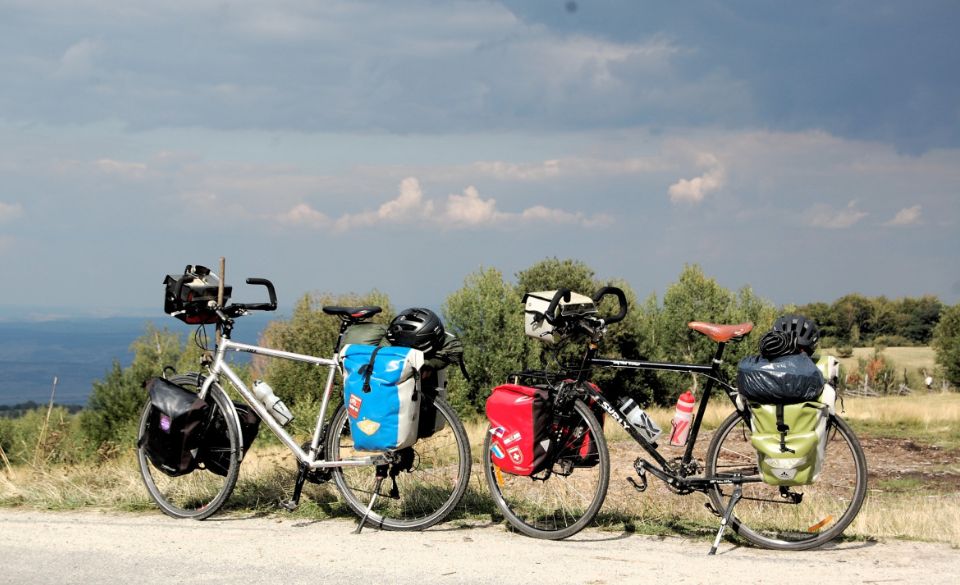
Simplified Steps for Cycling Around the World: A Practical Guide
Page Contents
So, the idea of cycling around the world appeals to you? Fantastic! Here’s a straightforward approach in three easy steps:
1. Acquire a bicycle
The specific type doesn’t matter much, as long as it’s comfortable. Without a bike, you won’t get far.
2. Resign from your job
For a global journey, you’ll need a few years, so inform your boss about your plans. (Skip this step if you are a student, unemployed, or retired.)
3. Begin your journey
To cycle around the world, you must start. Load up your bike, ask your neighbor to care for your pets, and pedal away from home.
Once you’ve completed these three steps, the rest will fall into place. Enjoy the ride!
Still not satisfied? Here are 11 optional steps to consider:
1. Conduct research
You could spend months gathering information about border crossings, visas, routes, and more. Alternatively, hit the road and trust your initiative and free WiFi to guide you.
2. Get fit
Instead of a gym membership and personal trainer, achieve fitness by cycling all day during your initial weeks on the road.
3. Save money
Rather than accumulating funds in the bank, sell your possessions and rely on resourcefulness to sustain yourself on the journey.
4. Buy equipment
Rather than splurging on top-tier gear, salvage items and repurpose them, saving significant travel funds.
5. Plan a route
While detailed planning is an option, embrace the freedom of cycling and let the road dictate your journey.
6. Limit social media use
Consider minimizing your digital obligations and fully experiencing life on Earth.
7. Seek sponsorship
Rather than spending months seeking sponsorship, work to buy what you need. Changes in plans won’t affect anyone but you.
8. Ride for a cause
Travel without feeling the need to justify it; acknowledge the long-term benefits to yourself and society.
9. Minimize media coverage
Recognize that the true freedom of cycle touring is often more real when done without an audience.
10. Preserve personal ties
Transform your domestic life to be sustainable on the road, ensuring continuity after your ride concludes.
11. Avoid records
Focus on enjoying each day rather than setting records, embracing the independence and flexibility of cycling.
Gather data, set goals, and actually complete the journey
Consider the relevance of tracking metrics, setting goals, and finishing your journey. Alternatively, allow your journey to evolve organically.
How long will it take to cycle around the world?
The duration it takes to cycle around the world can vary significantly based on factors such as the route chosen, individual cycling speed, and the number of rest days taken. On average, cyclists take about 1 to 2 years to complete a global journey. Some ambitious riders aiming for speed records may complete the journey in a matter of months, while others who prefer a more leisurely pace may extend their trip beyond two years. The specific route, weather conditions, and personal preferences all play crucial roles in determining the overall duration of the journey.
How much money do you need to cycle around the world?
The cost of cycling around the world can vary widely depending on factors such as travel style, accommodation preferences, and spending habits. On average, a cyclist might need anywhere from $10,000 to $25,000 per year for a global journey. This estimate includes expenses for food, accommodation, bike maintenance, visas, and other miscellaneous costs. Some cyclists choose a minimalist approach, relying on camping and budget accommodations, while others may opt for more comfortable options, impacting the overall budget. Additionally, unexpected expenses, such as gear replacement or emergency medical costs, should be factored into the budget.
Can you travel the world by bicycle?
Yes, traveling the world by bicycle is a feasible and increasingly popular adventure. Many individuals have successfully completed global cycling journeys, demonstrating that it is indeed possible. The key is thorough preparation, both physically and mentally, along with meticulous planning regarding the route, essential gear, and budget considerations. Cyclists need to be prepared for varying terrains, climates, and cultures as they traverse different countries and regions. While challenges may arise, the experience of cycling around the world offers unparalleled opportunities for cultural immersion, personal growth, and a unique perspective on the planet. It’s essential to have a reliable bicycle, proper gear, and a sense of adventure to embark on this extraordinary journey.
How far can you travel on a bike in a day?
The distance one can cover on a bike in a day depends on various factors, including the rider’s fitness level, the terrain, weather conditions, and the type of bicycle being used. On average, a recreational cyclist might cover anywhere from 40 to 60 miles (64 to 96 kilometers) in a day on flat terrain. However, experienced and well-trained cyclists, especially those undertaking long-distance touring, can cover over 100 miles (160 kilometers) or more in a day.
Factors that influence daily cycling distance include:
Fitness Level: A well-conditioned cyclist can sustain higher speeds and cover more distance.
Terrain: Hilly or mountainous terrain will naturally slow down a cyclist compared to flat landscapes.
Weather Conditions: Strong headwinds or adverse weather conditions can impact cycling speed and overall distance.
Type of Bicycle: Road bikes are generally faster on smooth roads, while touring or gravel bikes may be better suited for longer distances and varied terrain.
It’s important for cyclists to listen to their bodies, stay hydrated, and take breaks to avoid fatigue and injury. Additionally, factors like carrying a heavy load (for bike touring) or cycling at high altitudes can also affect daily distances.
What bike is best for long distance?
Choosing the best bike for long-distance cycling depends on the type of terrain you’ll be covering, your personal preferences, and the specific demands of your journey. Here are several types of bikes commonly used for long-distance cycling:
Road Bikes: Designed for speed on smooth roads, road bikes have lightweight frames and thin tires. They are efficient for covering long distances on paved surfaces.
Touring Bikes: Specifically built for loaded travel, touring bikes are designed to carry gear and provide a comfortable riding position. They often have a robust frame, sturdy wheels, and multiple attachment points for racks and panniers.
Gravel Bikes: Versatile and suitable for mixed terrain, gravel bikes have wider tires and more relaxed geometry than road bikes. They can handle a variety of surfaces, making them a good choice for long-distance rides with sections of unpaved roads.
Endurance Bikes: These bikes are designed for comfort on long rides. They typically have a more relaxed geometry, allowing for a more upright riding position. They often include features like disc brakes and wider tires.
Hybrid Bikes: Offering a mix of features from road and mountain bikes, hybrids are versatile and can handle a range of conditions. They may not be as specialized as other types but can still be suitable for long-distance rides.
Ultimately, the best bike for long-distance cycling depends on your preferences, the type of terrain you’ll encounter, and the specific demands of your journey. It’s crucial to test ride different bikes and consider factors such as comfort, gearing, and the ability to carry the necessary gear for your trip.
Final Words – Simplified Steps for Cycling Around the World
As you’ll discover, long-distance bike touring can be made more complicated than necessary. While additional steps may be relevant for some, many opt for simplicity. The majority of long-term touring cyclists, happily doing their own thing, often go unnoticed in the digital realm.
In conclusion, be cautious when scouring the web for advice. Taking unnecessary steps may complicate your dream. Follow steps 1 to 3, and only add extras if they genuinely align with your vision. Remember, when it comes to planning a round-the-world bike trip, less is often more.



